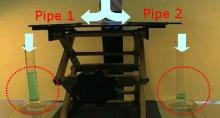Drag reduction: Flowing through pipes
In 1756, Leidenfrost observed that a droplet of water deposited on a hot surface does not instantly vaporize, but remains as a droplet for a considerable duration of time and slides freely across the solid surface. This is because a layer of water at the solid-water interface vaporizes and forms a cushion of air. The first scientific descriptions of possible air-cushioned vehicles first arose a century ago. By the 1950's, a technical solution to creating a layer of air between the hull of a boat and the surface of water to reduce drag had been found with the invention of the hovercraft, but this required the active production of a layer of air. Is it possible to create a superhydrophobic surface that always ensures water flows across a layer of air, thus lubricating its passage without the need for active input of energy? In the video above the flow of water through two millimetric diameter copper tubes is compared - the only difference in the tubes is that one has a superhydrophobic copper nanoribbon internal surface.
Publication
![]()
Superhydrophobic copper tubes with possible flow enhancement and drag reduction,
ACS Appl. Mater. Interfaces 1 (6) (2009) 1316-1323.
Via ACS server
![]()
Immersed superhydrophobic surfaces: Gas exchange, slip and drag reduction properties,
Soft Matter 6 (4) (2010) 714-719. View postprint pdf
![]()
Plastron induced drag reduction and increased slip on a superhydrophobic sphere,
Soft Matter 7 (21) (2011) 10100-10107. View postprint pdf


